The Manamoc Island project site visit was planned over a year in advance, and included in the itinerary was a visit to the Tubbataha Reefs Natural Park. However, when news came out that a US Navy minesweeper ran aground at Tubbataha’s south atoll while on its way to Indonesia, we got worried.
It was bad, but not as bad as we expected. As of last report, about  2,345 square meters of the reef was determined to have been damaged when the USS Guardian was finally removed last March 30. First estimates put the figure at 4,000 square meters. Two dive spots were affected and had to be closed so the area can be allowed to recover.
2,345 square meters of the reef was determined to have been damaged when the USS Guardian was finally removed last March 30. First estimates put the figure at 4,000 square meters. Two dive spots were affected and had to be closed so the area can be allowed to recover.
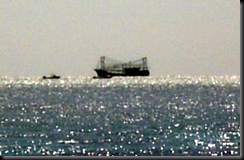 Then a Chinese fishing boat, F/N Min Long Yu, also ran aground a mere two nautical miles from the ranger station at the southwestern end of the north atoll one week before our trip. Initial news reports said that no marine products were found, and that is accurate. But the rangers we visited told us of their bizarre discovery within the wayward boat’s hull that fueled the news while we were at sea.
Then a Chinese fishing boat, F/N Min Long Yu, also ran aground a mere two nautical miles from the ranger station at the southwestern end of the north atoll one week before our trip. Initial news reports said that no marine products were found, and that is accurate. But the rangers we visited told us of their bizarre discovery within the wayward boat’s hull that fueled the news while we were at sea.
The fishing boat was still stuck on the reef when we made our visit 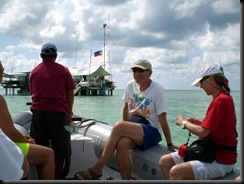 to the Tubbataha Ranger Station. On duty at the isolated outpost were Erli Bundal (Philippine Navy) and Norwin Nuevo (Philippine Coast Guard). According to Mr. Bundal, the fishermen on board tried to bribe them with US$2,400 for their quick release. The culprits are now detained in some jail at Puerto Princesa. Their alibi, as far as the bribery charge is concerned, is that they were misunderstood owing to the language barrier, that the money was not a bribe but a proffer in exchange for assistance to extricate their vessel from the reef.
to the Tubbataha Ranger Station. On duty at the isolated outpost were Erli Bundal (Philippine Navy) and Norwin Nuevo (Philippine Coast Guard). According to Mr. Bundal, the fishermen on board tried to bribe them with US$2,400 for their quick release. The culprits are now detained in some jail at Puerto Princesa. Their alibi, as far as the bribery charge is concerned, is that they were misunderstood owing to the language barrier, that the money was not a bribe but a proffer in exchange for assistance to extricate their vessel from the reef.
What was not in the news at first is that the rangers, while removing the fishing nets, chanced upon some 500 sacks of dried balintongs, an endangered sub-species of scaly anteaters endemic to Palawan island. These would probably have landed in the shelves of Chinese drugstores alongside rhino horns and dried geckos and scorpions had they not been intercepted. There are laws, such as the Strategic Environment Plan for Palawan Act and the Wildlife Resources Conservation and Protection Act, that provide for penalties for trading in rare 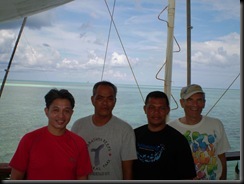 and endangered species, but it goes on anyway. Traditional Chinese medicine prescribes ground-up anteater scales for cancer, asthma, or to stimulate lactation. One can go on and on with a clinical discourse about poverty-driven poaching and the international pseudo-medicine that drives it, but as with many other issues, nothing wells up frustrations stirred by feckless government efforts to save endangered species higher than an actual incident so close to home.
and endangered species, but it goes on anyway. Traditional Chinese medicine prescribes ground-up anteater scales for cancer, asthma, or to stimulate lactation. One can go on and on with a clinical discourse about poverty-driven poaching and the international pseudo-medicine that drives it, but as with many other issues, nothing wells up frustrations stirred by feckless government efforts to save endangered species higher than an actual incident so close to home.
For now however, the issue that at least has in place some preventive measures, is the protection and conservation of the Tubbataha ecosystem. A UNESCO World Heritage Site covering a little over 130,000 hectares, the Tubbataha reefs include the north and south atolls, as well as the Jessie Beazley Reef. It is a wide expanse that is obviously much too big for the valiant efforts of a tiny ranger station. However, plans are underway for another, more electronically sophisticated ranger station, which should contribute a whole lot more in warding off errant vessels before damage is inflicted.
Scuba diving in Tubbataha is a privilege. Not only is it accessible 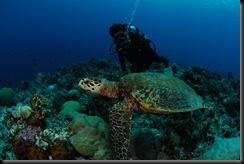 only by liveaboards, the marine life is unlike any other in the country. Sharks, turtles, stingrays, tunas and other large marine animals are mostly so curious that many of us were able to observe them up-close. While there were a few patches of rubble, most probably remnants of blast fishing before serious protection measures were instituted, the coral gardens are nothing short of magnificent. The long hilly stretch of dense staghorns at the south atoll is certainly very impressive.
only by liveaboards, the marine life is unlike any other in the country. Sharks, turtles, stingrays, tunas and other large marine animals are mostly so curious that many of us were able to observe them up-close. While there were a few patches of rubble, most probably remnants of blast fishing before serious protection measures were instituted, the coral gardens are nothing short of magnificent. The long hilly stretch of dense staghorns at the south atoll is certainly very impressive.
A whale shark swam below us during one wall dive, hawksbill and green turtles did not care whether we were virtually nose to nose  with them on other dives, and schools of barracudas and trevally jacks were sighted on several dives. And then there are the reef sharks. Black tips, white tips, and grey reefs are so numerous one could be lulled into thinking that these are ordinary fare on scuba dives anywhere. A wholly visible nurse shark on a ledge that just allowed us to gawk at it for as long as we wanted was a highlight of one of our night dives.
with them on other dives, and schools of barracudas and trevally jacks were sighted on several dives. And then there are the reef sharks. Black tips, white tips, and grey reefs are so numerous one could be lulled into thinking that these are ordinary fare on scuba dives anywhere. A wholly visible nurse shark on a ledge that just allowed us to gawk at it for as long as we wanted was a highlight of one of our night dives.
Arguably, the key to Tubbataha’s beauty is its remoteness to human activity. Other reefs are often too close to human settlements that they are extremely vulnerable to over-extraction and degradation. That is unless the island community nearest the reef actively protects and conserves it. And this is precisely what is happening in Manamoc Island.
One of the major problems besetting island communities like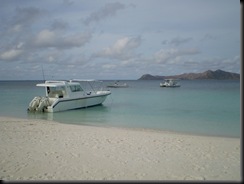 Barangay Manamoc is lack of reliable electricity. Its generators depend on fossil fuel, which has to be imported to the island and is very much susceptible to price increases. The relatively high cost of power makes it very difficult for barangay public facilities to provide efficient and effective services to the community. Moreover, the community's generators are usually turned on only at dusk (and turned off at midnight), to provide light for the village. In their high school for instance, students and teachers, before a covenant with Seacology was reached, had to shell out personal money to purchase
Barangay Manamoc is lack of reliable electricity. Its generators depend on fossil fuel, which has to be imported to the island and is very much susceptible to price increases. The relatively high cost of power makes it very difficult for barangay public facilities to provide efficient and effective services to the community. Moreover, the community's generators are usually turned on only at dusk (and turned off at midnight), to provide light for the village. In their high school for instance, students and teachers, before a covenant with Seacology was reached, had to shell out personal money to purchase 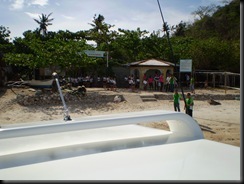 gasoline for the sole generator set within the school to power at least 2 of the 6 working computer units in their classroom.
gasoline for the sole generator set within the school to power at least 2 of the 6 working computer units in their classroom.
In 2008, in exchange for their commitment to protect a nearby 108-hectare Marine Protected Area (MPA), Seacology funded several solar power supply systems for their community health center, village hall, community training cum multi-purpose center, public high school, public elementary school and the pre-school center. Our partner on the ground, the Andres Soriano Foundation (ASF), has been reporting that the solar power systems have been continuously serving the community well, and that the MPA is strictly being enforced as a no-take zone.
serving the community well, and that the MPA is strictly being enforced as a no-take zone.
Last Sunday, April 21, 2013, Seacology Board Member Lucien d'Sa, Executive Director Duane Silverstein, myself and other Seacology guests got to see for ourselves what is actually happening on the ground.
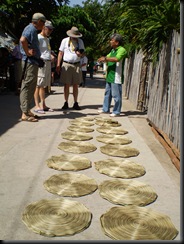 On our arrival, we were met by dancing children, ASF staff, and barangay officials who briefed us on the status of the MPA. It was reported that the reef suffered a crown of thorns infestation in 2008 but that it has since recovered. The chart we were shown graphed a fish count low of 1,479 in 2008 that dramatically increased to 4,826 in 2012. Also shown was the health of the corals in the MPA, which as of May 6, 2012 was comprised of 50% hard coral, 15% sand, 12% soft coral, 12% rubble, and 11% dead coral with algae. For perspective, there was only 25% mean hard coral cover in 2008.
On our arrival, we were met by dancing children, ASF staff, and barangay officials who briefed us on the status of the MPA. It was reported that the reef suffered a crown of thorns infestation in 2008 but that it has since recovered. The chart we were shown graphed a fish count low of 1,479 in 2008 that dramatically increased to 4,826 in 2012. Also shown was the health of the corals in the MPA, which as of May 6, 2012 was comprised of 50% hard coral, 15% sand, 12% soft coral, 12% rubble, and 11% dead coral with algae. For perspective, there was only 25% mean hard coral cover in 2008.
More importantly, the success of the MPA is being felt by the 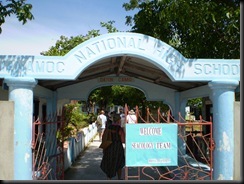 community’s fisherfolk who are having better catches just beyond the MPA.
community’s fisherfolk who are having better catches just beyond the MPA.
The villagers have organized their own Bantay Dagat or Fish Wardens who continuously patrol the MPA. Poachers, invariably other fisherfolk originating from neighboring islands, are apprehended and fined. Through the fines collected, the villagers were eventually able to purchase a patrol boat exclusively for this purpose.
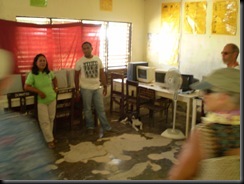 After the brief presentation at the beach, we were toured around the village where we saw the solar power systems at work, most notably at the health center where temperature-sensitive medicine such as vaccines are now kept refrigerated, and the national high school where the few functioning units in the computer lab have become usable for at least a few hours during schooldays.
After the brief presentation at the beach, we were toured around the village where we saw the solar power systems at work, most notably at the health center where temperature-sensitive medicine such as vaccines are now kept refrigerated, and the national high school where the few functioning units in the computer lab have become usable for at least a few hours during schooldays.
Our visit ended at the ASF Staff House in the island, where the  admirable work of our partner organization in the island was explained in detail. There are many more challenges besetting Barangay Manamoc and the other outlying islands, but in a small way they are certainly fortunate to have NGOs such as the ASF watching out for them.
admirable work of our partner organization in the island was explained in detail. There are many more challenges besetting Barangay Manamoc and the other outlying islands, but in a small way they are certainly fortunate to have NGOs such as the ASF watching out for them.
 This year’s Seacology Expedition to Tubbataha and Manamoc Island offers critical lessons in the management of the earth’s remaining wildlife and resources. A single ship grounding can instantly obliterate wide areas of coral growing for decades, if not centuries. Wanton poaching, for whatever purpose, can drive species to extinction. And a small island community taking responsibility for the protection of its marine resources can cause it to flourish, translating to increased bounty from designated fishing areas.
This year’s Seacology Expedition to Tubbataha and Manamoc Island offers critical lessons in the management of the earth’s remaining wildlife and resources. A single ship grounding can instantly obliterate wide areas of coral growing for decades, if not centuries. Wanton poaching, for whatever purpose, can drive species to extinction. And a small island community taking responsibility for the protection of its marine resources can cause it to flourish, translating to increased bounty from designated fishing areas.
[Underwater photos courtesy of Randy Wright, Atlantis Azores boat captain who would dive with us occasionally.]